I've Lived in Kentucky for Decades and Finally Took a Road Trip on the Bourbon Trail — Here's Why It Was Worth It
A historian uncovers the complex story of her home state’s famous spirit, one strong sip at a time.
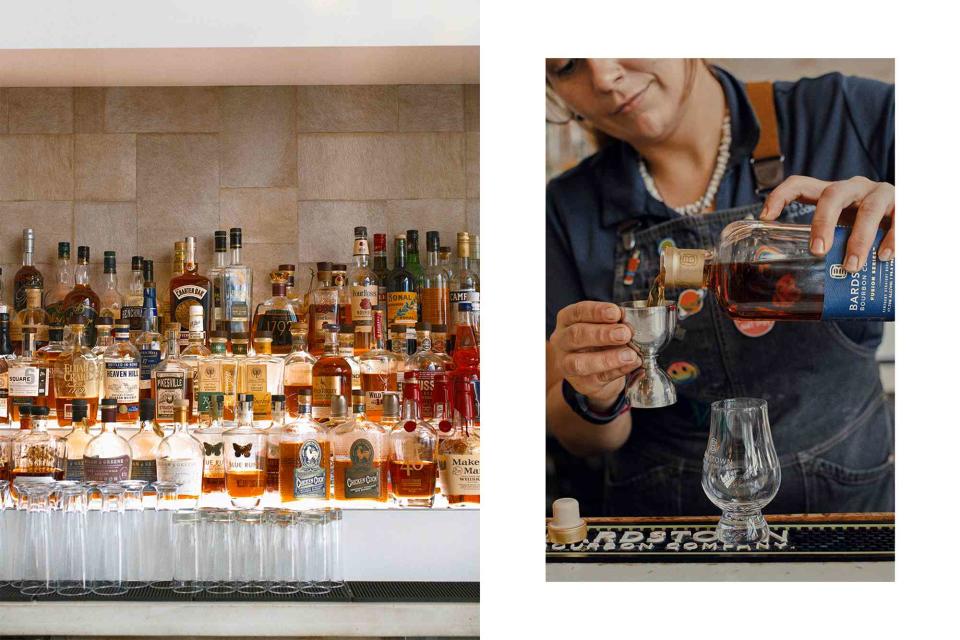
Ashley Camper
From left: Behind the bar at the Kitchen & Bar at Bardstown Bourbon Co.; pouring the Bardstown Fusion Series #9 blend.Growing up in Louisville, I knew about bourbon. I played my first game of spin the bottle with a grade-school classmate who was named after his family’s brand, Very Old Barton. Yet, by the time I started drinking hard alcohol (too young), my idea of a delectable cocktail was a very strong vodka tonic with two wedges of lime.
It turned out I wasn’t alone. In the early 1970s, sales of vodka surpassed those of America’s native spirit for the first time. Facing a shrinking market, bourbon makers of the 1970s and 80s wandered into other industries. My friend’s family, along with many other distillers, cashed out to conglomerates. By the early 90s, the unimaginable had occurred. “Even Kentuckians had stopped drinking it,” Susan Reigler, who has authored six books on the spirit and has been called the “headmistress of bourbon,” told me.
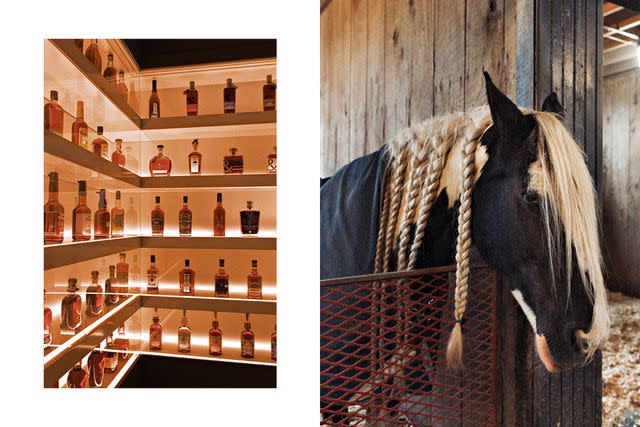
Ashley Camper
From left: Bourbon bottles at the Frazier History Museum, in Louisville, Kentucky; a horse at Hermitage Farm, in Goshen.Bourbon’s course through the body, from lips to throat to chest to belly, can feel like lava, an effect known as a “Kentucky hug.” Even Rob Samuels, managing director of Maker’s Mark, has conceded, “You almost had to work hard to like it.” And for many, the spirit’s classic cocktail — the aromatic and potent Old-Fashioned — came with too strong a whiff of the Old South. As a graduate student in history during the late 1980s, I watched white men use bourbon as a way of brandishing their power. At an academic conference, an eminent scholar informed his junior colleague — Catherine Clinton, now a prestigious historian in her own right — that to fit in she needed to drink bourbon. Not a fan? Not a problem, he said. She would get used to it if she brushed her teeth with the stuff for a week.
But tastes change. Today the bourbon business is booming. There are more than 11 million barrels aging across the state. Between 2009 and 2021, the number of whiskey-distilling operations in Kentucky soared from 19 to 95, and a new premium craft brand seems to crop up every few months. On weekends, a stream of bachelor and bachelorette parties pours into Lexington and Louisville; couples are even tying the knot at stylish distilleries.
"Bourbon’s course through the body, from lips to throat to chest to belly, can feel like lava, an effect known as a “Kentucky hug.”"
I’ve spent most of my life in the Bluegrass State, so tradition dictated that I drink mint juleps annually at Derby parties, when everybody else did. But even last year, I couldn’t have told you the difference between a mash bill and a duck bill. I’m a historian who has studied Southern writers and Southern families. I have even written a book about the troubling origins of the song “My Old Kentucky Home.” But I had virtually ignored the bourbon comeback. How did this spirit reverse its course? My historian’s bag in hand, I set off on a chilly winter ride along the bourbon trail.
At the start of my first full day as a bourbon tourist, I ducked out of Hotel Distil in Louisville, where I’d spent the night, for a jog across the Big Four Bridge, a pedestrian walkway that spans the Ohio River and connects Kentucky to Indiana. I was almost back at the Distil when I fell in with a line of people stretching down a block of West Main Street known as Whiskey Row. Apparently, they were bourbon hunters waiting for a special release from the Old Forester Distillery. It was on this street that, in the years after the Civil War, bourbon was hauled from the countryside — where it was made as a means of using up surplus corn and grain — and then sold or stored.
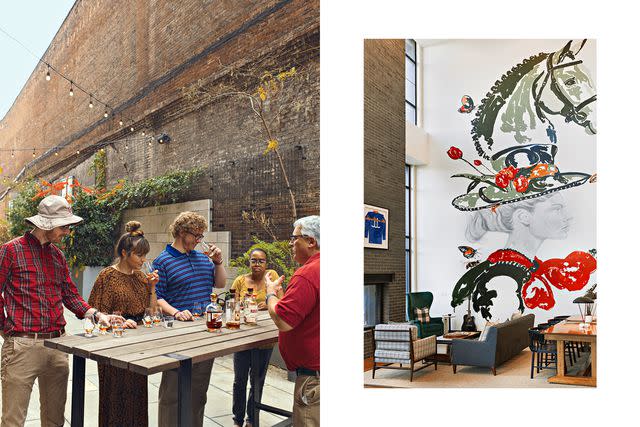
Ashley Camper
From left: A bourbon tasting at the Frazier History Museum; the lobby at Origin Lexington.I had my first official tasting later at Hermitage Farm, an easy 30-minute drive northeast of Louisville. This Thoroughbred horse farm combines bourbon tastings from distilleries around the state with hyperlocal food (cast-iron corn bread with sorghum brown butter; whole trout with butter beans), all in a single agritourism package. Seated at the Barn8 bar, bathed in whiskey-gold light, I sipped an Old-Fashioned made with foraged-hickory-nut syrup. I tasted more forest than fire, and my hesitation about the spirit began to fade.
Bourbon making is “gloriously inefficient,” Reid Mitenbuler noted in his seminal text, Bourbon Empire: The Past and Future of America’s Whiskey. The mixture must be at least 51 percent corn and should contain wheat, rye, and malted barley. It also takes time: for bourbon to be designated “straight bourbon whiskey,” it must have aged in new charred white-oak barrels for a period of at least two years. (Another thing to know: don’t believe anyone who tells you with certainty who invented the spirit or how it got its name. That much is lost to time.)
Variables like where in the warehouse a barrel is stored (hotter up high, cooler below) can also produce vastly different results. As the barrels expand and contract with the temperature, the charred-wood flavors press into the liquid, turning the clear “white dog” into a golden-brown mix. One of my guides called that microscopic motion “the heartbeat of Kentucky.”
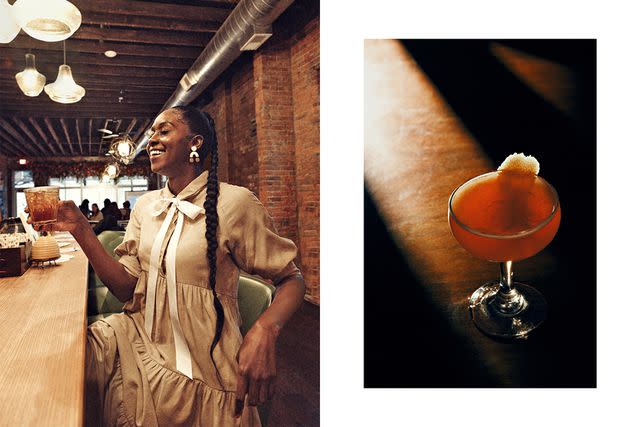
Ashley Camper
From left: Raising a glass at Trouble Bar, in Louisvilleâs Shelby Park neighborhood; Honeywood restaurantâs Barrel Pick Boulevardier, made with bourbon, Campari, sweet vermouth, and orange.That afternoon, heading south out of Louisville, I drove along Jefferson Memorial Forest and into the part of the state known as the “Knobs”: miles of undulating, isolated hills, which at that time of year bristled with winter trees like a stubbly beard. I passed by knob after knob until eventually I noticed a billboard informing me I’d entered Jim Beam Country — a reminder that I had four distilleries to visit in the next 36 hours.
I picked up the basics from my time at Heaven Hill Distillery, Bardstown Bourbon Co., Castle & Key, and Log Still Distillery. I learned about “mash bills”: the proportion of corn, barley, and rye used in the bourbon. Brands used to hold these measurements closer than Colonel Sanders kept the fried-chicken recipe; now transparency is generally the rule, with percentages available on company websites.
Related: This Kentucky City Is the 'Horse Capital of the World'
At each distillery, I could smell before I saw the vats, or “cookers,” each one typically containing 12,000 gallons, burping with warm, yeasty fermenting grains. (This beery odor is affectionately known as “Kentucky cologne.”) The mash is pushed through stills, a process that extracts vaporized alcohol from the residue, which can then be fed to livestock. Aside from witnessing the processing and taking part in a tasting, visitors might get to peer into a fire-toasted barrel ready for filling, walk through barrel storage sheds called rickhouses, or peek at the bottling area. Some distilleries have hands-on experiences: a mixology class or the chance to “thieve” a taste, a term for sampling bourbon straight from a barrel.
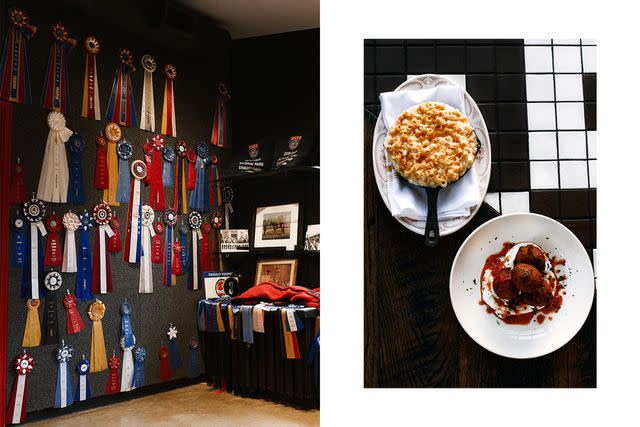
Ashley Camper
From left: The ribbon room at Heritage Farm; mac and cheese and sweet potato beignets at Honeywood.The touring-tasting-dining trend may be most fully realized at Bardstown Bourbon Co., founded in 2014. It appears almost like a campus, with a glass-walled visitors’ center, grain labs, a tasting lounge, a library with more than 400 bourbons and ryes dating back as far as 1892, and a thieving room. The airy and cheerful Bardstown Bourbon Kitchen & Bar attracts an industry crowd at lunchtime, though first-timers are welcome, too: the distillery offers 10 different tours and experiences, including a VIP fill-your-own-bottle tour and, on some summer Friday evenings, live music on the patio. BBC produces its own bourbon, as well as spirits on contract for more than 30 other brands. Though now almost a decade old, its sleek, multistory rickhouses don’t yet smell of “barrel candy,” the sticky drippings that accumulate from generations of stacked casks.
Age and masculinity have long characterized bourbon branding. It was right there in the names: Old Sport, Old Fitzgerald, Old Grand-Dad, Old Rip Van Winkle, Old Crow. A patina of longevity communicated stature. It all spoke of a troubling past that, in recent years, the industry has begun to reckon with. Rebel Yell, a brand that launched in the 1960s in the midst of the Civil Rights Movement, took its name from the Confederate battle cry and was marketed only in Southern states. (The brand has since dropped the “Yell.”)
Many drinkers may not know that an enslaved Tennessean, Nathan “Nearest” Green, taught the biggest name in American whiskey, Jasper “Jack” Daniel, how to make the stuff. In 2016, Jack Daniel's began to embrace this story by offering tours highlighting Green’s contributions. Three years later, Fawn Weaver, the author who discovered Green’s story and decided to resurrect his legacy, opened the Nearest Green Distillery in Shelbyville, Tennessee. Victoria Eady Butler, a descendant of Green’s, now holds the title of master blender there. That’s Tennessee whiskey, but who knows how many Uncle Nearests have been excluded from the Kentucky bourbon story?
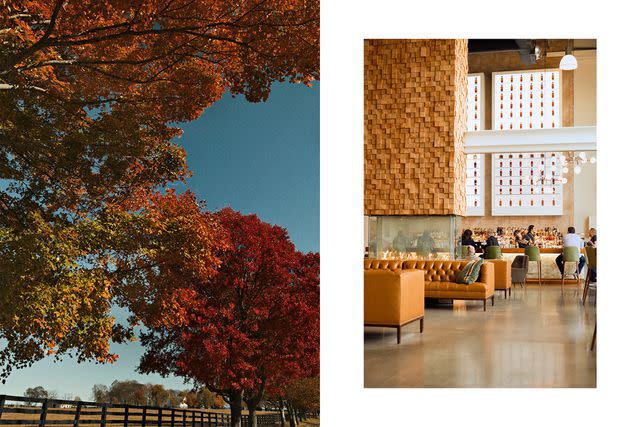
Ashley Camper
From left: Fall foliage on the Old Frankfort Pike National Scenic Byway; the Kitchen & Bar at Bardstown Bourbon Co.Many drinkers may not know that an enslaved Tennessean, Nathan “Nearest” Green, taught the biggest name in American whiskey, Jasper “Jack” Daniels, how to make the stuff. In 2016, Jack Daniels began to embrace this story by offering tours highlighting Green’s contributions. Three years later, Fawn Weaver, the author who discovered Green’s story and decided to resurrect his legacy, opened the Nearest Green Distillery in Shelbyville, Tennessee. Victoria Eady Butler, a descendant of Green’s, now holds the title of master blender there. That’s Tennessee whiskey, but who knows how many Uncle Nearests have been excluded from the Kentucky bourbon story?
The Frazier History Museum, in Louisville, offers a tour called “The Unfiltered Truth: Black Americans in Bourbon.” Visitors learn about Elmer Lucille Allen, the first African-American chemist at Brown-Forman distillery, and the contributions of other Black Kentuckians to the bourbon industry. Currently, however, Kentucky has only two Black-owned bourbon distilleries: Brough Brothers, founded in 2021, and Fresh Bourbon Distilling Co., founded in 2020.
Bourbon also has a reputation as being a man’s drink, but it was women who created the modern bourbon trail. One of them, Peggy Noe Stevens, was running Woodford Reserve’s visitors’ center in 1999 when she and two female peers from other distilleries proposed cross-marketing their tours. They produced a brochure that listed the seven places where visitors could see the spirit in the making (today there are 46). Now an author and consultant, Stevens also founded the Bourbon Women Association in 2011.
More Trip Ideas: Mammoth Cave National Park Has the Longest Cave System In the World
One intriguing female-led brand is Pinhook, which produces ryes and bourbons in annual vintages, much like wine. “This gives it a natural crossover appeal for women who drink wine,” said Alice Peterson, Pinhook’s CEO. “I love that we no longer have to market solely to the leather-sofa-and-cigars crowd.”
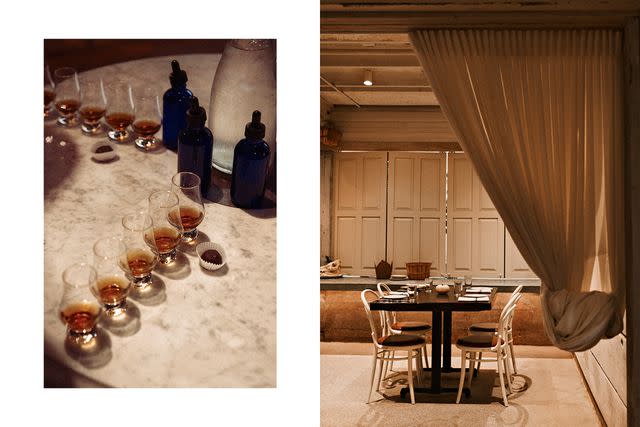
Ashley Camper
From left: A tasting at Heaven Hill; Hermitage Farmâs Barn8 restaurant, in Goshen.I found a similar ethos at Trouble Bar, a tavern in Louisville’s Shelby Park neighborhood. I ordered the Galactic Diamond — bourbon, plum, green-tea syrup, and lime — and sat down with co-owner Kaitlyn Soligan Owens, who moved to Louisville from New York City in 2013. She founded a bourbon tour agency, Matson & Gilman, with her best friend, Nicole Stipp. By 2019 they wanted a brick-and-mortar place where they could hold tastings; eventually, a bar followed. Owens and Stipp aim to disrupt bourbon’s perceived “bro culture” by intentionally welcoming LGBTQ patrons and young, progressive customers. The bar’s music tends toward Sam Cooke and Lizzo, and photos of social-justice “troublemakers” — including Alberta Odell Jones, one of Kentucky’s first Black female lawyers, who was murdered in a still-unsolved case — cover one of the walls.
Trouble Bar offers special flights chosen by notable women in bourbon — Stevens and Weaver both contributed, as have female distillers around the state. Owens pointed out that one of the spirit’s greatest innovators was Margie Samuels, who cofounded Maker’s Mark with her husband, Bill, in 1953. Margie was responsible for both the name and the literal mark — she used her home fryer to melt red wax, into which she hand-dipped the bottles to seal them.
Some of the trees at Castle & Key distillery have a witchy look. That’s because they’re blackened with a fungus called Baudoinia compniacensis, which thrives on the “angel’s share” of ethanol that evaporates from the bourbon barrels (because the vapor floats away in the air, it’s described as being consumed by angels). Some distillers have been sued because the fungus discolored nearby homes, patios, and automobiles, though there is not sufficient evidence to say that the growth harms people or animals.
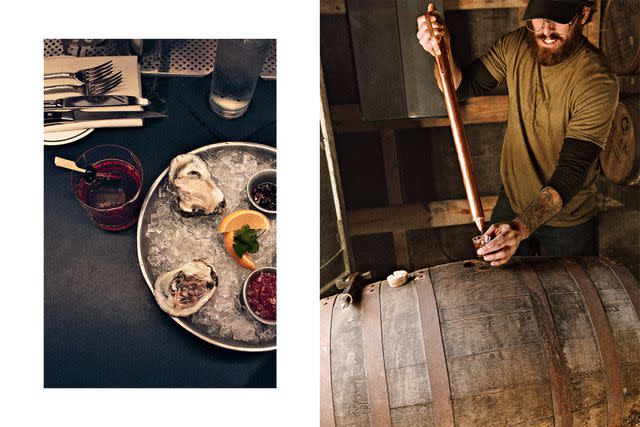
Ashley Camper
From left: An Old-Fashioned and oysters at Repeal; sampling from the barrel at Castle & Key.Reached by a narrow, steep road outside Frankfort, the state capital, Castle & Key shows how today’s bourbon tourism sometimes builds atop existing foundations. The “castle” is a crenellated 1887 showpiece built by whiskey maker Colonel E. H. Taylor Jr., who is often seen as the father of the modern bourbon industry. The train tracks that Taylor laid to move his product also carried Victorian-era visitors to what was perhaps the first bourbon-tourism experience: people could stroll and picnic in the gardens and admire the grounds and structures, like the “key,” a lock-shaped pool beneath an elaborate pergola. Prohibition forced the closing of the distillery in 1920, and the property fell into ruin as it passed through multiple owners, before finally reopening in 2018. While the bourbon products age — the inaugural small-batch Kentucky Straight wasn’t released until March 2022 — head blender Brett Connors uses juniper berries and other plants to flavor the four gins that are also on offer.
Bourbon also has a reputation as being a man’s drink, but it was women who created the modern bourbon trail.
Castle & Key has reenvisioned Taylor’s fairy-tale buildings and grounds as a place for locals and tourists to listen to live music, drink cocktails like a Bourbon Highball, with spiced honey, yuzu, and lemon, and eat pulled-pork sandwiches from food trucks like BubbyQ. “It’s about how you create a sense of place,” Connors said. “That’s what people remember more than tasting or even tours.”
Lately, bourbon seekers are also after something that has long eluded them: a place to stay after a day of tastings. One of the few places that make that possible is Dant Crossing, a 300-acre destination in Gethsemane, about an hour south of Louisville. There you’ll find 23 rooms spread across a handsome farmhouse building, a Georgian-style home, two cottages, and an exclusive-use lodge. (A farm-to-table restaurant is projected to open next year.) Next door is Log Still Distillery, which has a bar and tasting room, plus a 2,300-seat amphitheater for (mostly) country music performances.
Three cousins — Wally, Lynne, and Charles Dant — inspired by their forebear’s pre-Prohibition bourbon operation — reunited to create the new distillery. (The well-known J. W. Dant bourbon brand, owned by Heaven Hill, is separate.) For the Dants, the journey home has been long like a country mile, which was, fittingly, the name of the cocktail, made with wheated bourbon and dusted with fennel, that I sipped before dinner. Each course — my favorite was the fried game hen with compressed gin watermelon squares and hot honey — had its own cocktail pairing. When it was over I gladly accepted a golf-cart ride back to my room.
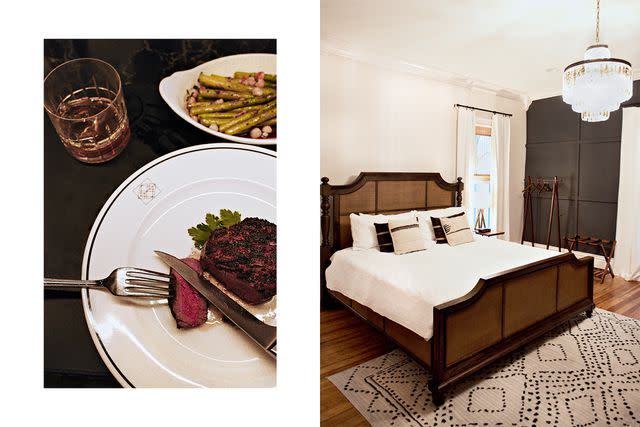
Ashley Camper
From left: Oak-fired steak with asparagus at Repeal, the restaurant at Louisvilleâs Hotel Distil; a guest room at Dant Crossing, in Gethsemane.The story of bourbon, I found, does not end with the drink itself. The liquor has also become part of the arc of Kentucky’s cuisine. Chef Ouita Michel, who has racked up eight James Beard Award nominations and built a 10-restaurant mini empire throughout the state, uses the spirit as an ingredient, but even more as a narrative device. “Bourbon is a fantastic pillar for Kentucky,” she said, “but how do we enrich that story and make it about our people, our places?” She named one of her Lexington restaurants, Honeywood, after Honeywood Parrish Rouse, a legendary Southern hostess who paused at 4 p.m. every day to pour herself a glass of Old Fitzgerald. (I also think of the late Black feminist bell hooks, a Kentuckian who paired “brutal honesty with bourbon.”)
When Michel did her culinary training in the late 1980s and early 90s, she told me, bourbon was not on most people’s radar. Then, 20 years ago, she entered a cooking contest organized by Woodford Reserve and took home the prize for a sea-scallop dish with bourbon in the sauce. That led to 11 years as chef-in-residence at Woodford’s distillery in Versailles. Michel’s first restaurant, Holly Hill Inn, which opened in the town of Midway in 2001, is still one of the best places to get regional specialties like spoon-bread soufflé.
Thanks to the bourbon touring boom, Holly Hill is no longer under the radar. Michel has now counted license plates from all 50 states in the parking lot of Wallace Station, her sandwich shop on Old Frankfort Pike, a National Scenic Byway just outside Lexington. “It’s a sea change,” she said.
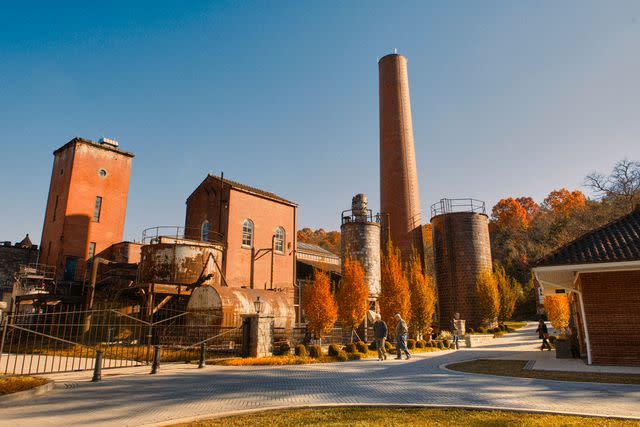
Ashley Camper
The grounds of Castle & Key distillery, near Frankfort.I could never distill the essence of Kentucky, a name with a rough beauty that conjures images of green grass and mountain hollers, of icons like Muhammad Ali and Loretta Lynn. Our spirit makers would like you to think that essence is bourbon. I was reminded time and again of its hold.
Journeying along the Kentucky Bourbon Trail showed me just how big a business my state’s signature spirit has become. To experience it fully, go slowly and trace the path of history, knowing that myth is always close behind. Along the way, be sure to stop often for the surprises. Bourbon itself was mine. The heat that comes with each sip is a reminder of Kentucky’s complexity and depth. Give it to me straight, with a single cube of clarifying ice.
Where to Stay
Bardstown Motor Lodge: A restored 1950s property with retro rooms and a poolside bar serving bourbon slushies.
Dant Crossing: Lodgings at this pastoral escape near Log Still Distillery in Gethsemane range from single rooms to a four-bedroom home. Breakfast is delivered to your door.
Hotel Distil, Autograph Collection: An urban Louisville retreat that leans in to bourbon history: its lobby features stoneware jugs once used for whiskey storage, and every night at 7:33 p.m. there’s a toast to the 1933 repeal of Prohibition.
Origin Lexington: A sophisticated stay in the heart of the city. The hotel also partners with Knob Creek Distillery on a private-label bourbon, available at its restaurant, 33 Staves.
Where to Eat and Drink
Holly Hill Inn: Chef Ouita Michel’s original Midway restaurant remains the region’s most elegant night out.
Honeywood: For a more casual meal, Michel also operates this Lexington hot spot with inventive dishes like sweet-potato beignets and smoked-catfish dip.
Nami: Tired of fried chicken? Celebrity chef Ed Lee’s new Louisville restaurant serves bibimbap, hand-cut noodles, and Korean barbecue with all the fixings.
Trouble Bar: Try bourbon you’ve never heard of at this cheeky Louisville watering hole, where the 17-page menu is an education in itself.
What to Do
Bardstown Bourbon Co.: A modern, Napa Valley–style approach to bourbon tourism, with sleek tasting facilities and a fantastic restaurant and bar.
Castle & Key: This distillery’s serene gardens are perfect for a midday stroll between tastings.
Frazier History Museum: A Louisville institution with comprehensive exhibits on Kentucky history, the Civil War, and the bourbon industry.
Heaven Hill: Founded in 1935, this remains America’s largest independent family-owned bourbon distillery.
Hermitage Farm: The best of Kentucky in one 700-acre package: bourbon from around the state, horses, and country cooking.
A version of this story first appeared in the October 2023 issue of Travel + Leisure under the headline "Still Life."
For more Travel & Leisure news, make sure to sign up for our newsletter!
Read the original article on Travel & Leisure.

